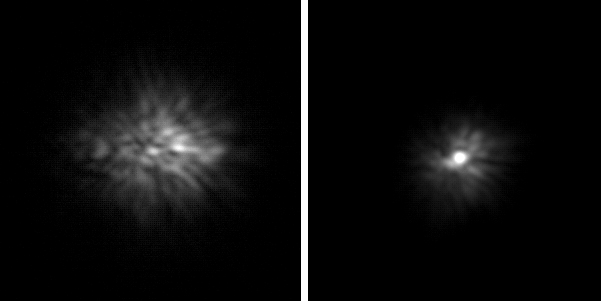We are proud to announce that our Portable Adaptive Optics (PAO) is working extremely well for the first time with nighttime stellar target, at very bad weather.
On July 11, 2013, on a cloudy night with some isolated thunder storm nearby, the sta rArcturus was only available on the sky for a few hours. However, our portable AO was able to lock on the star, and provide excellent atmospheric wave-front correction in the visible (0.45 - 0.9 um wavelengths).
Bellowing are twomovies with AO off without AO correction and AO on with AO correction. The observationwas made with the 1.6-m McMP solar-stellar telescope located at the National Optical Astronomy Observatory (NOAO) Kitt Peak, U.S.A.
http://www.csun.edu/~rd436460/Documents/Star_AO_off_41.avi
http://www.csun.edu/~rd436460/Documents/Star_AO_on_1.avi
Figure 1 and Figure 2 shows the typical images of the starArcturus and Sunspot 1787 with the AO off and AO on, respectively.

Figure 1.Arcturus images captured on the McMP with PAO off(left)and PAO on(right).
The same AO systemwas also used for solar observation in the same day with the same telescope (of course, with difference wave-front sensor). Here are the movies with AO off and AO on, at the 0.65 um visible wavelength for the Sunspot 1787.
http://www.csun.edu/~rd436460/Documents/Solar_AO_off_47.avi
http://www.csun.edu/~rd436460/Documents/Solar_AO_on_67.avi

Figure 2.sunspot 1787images captured on the McMP withPAOoff(left)and PAO on(right).
Please note that current AO with big telescopes (such as the 8-m Gemini telescopes) can only provide atmospheric wave-front correction effectively in the long wavelength, such as the near infrared or longer.High-resolution imaging in the visible is extremely challenging, and no any AO system can provide high-resolution imaging in the visible. The image quality will be much better, if our AO correction was made in the near infrared.
As a summary, our portable AO system, with a compact physical size, is able to deliver excellent imaging quality, and is indicating that it has the potential to be one of the best AO systems.
This project is performed by the Research Group for Exoplanet High-Contrast Imaging and Extreme AO, jointed by Nanjing Institute of Astronomical Optics & Technology (China) and California State University Northridge (USA), and supported by NSFC under grant #11220101001".